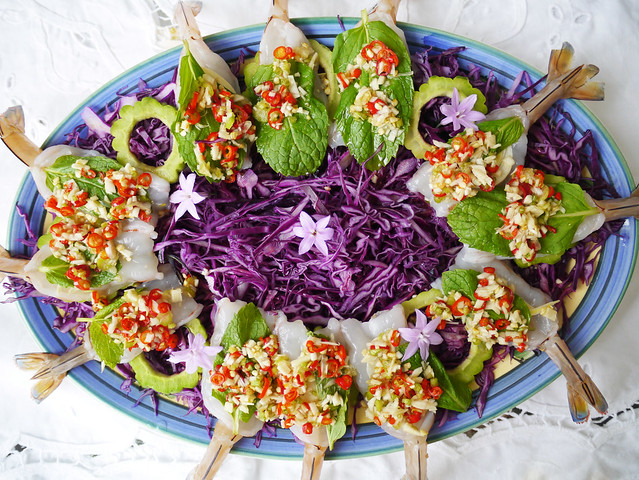
“Goong che nam pa”, freshly made and ready to eat, served with slices of bitter melon and garnished with edible society garlic flowers.
[dropcap]One[/dropcap] thing that I love about the Aussie summer holidays, especially if you’re near the coast, is the pleasure of eating fresh seafood. The local fish and chip shop will not disappoint you with their classic fried food packs, and if you’re the patient kind, you can always try your luck at catching your own fish. However, with some simple gear, and if you read the moon and tide cycle correctly (hint: locals are good for this, or try this website), you can embark on the joy of catching your own prawns. One evening, after careful calculation and weeks of patience, when the moon and tide were just right, we did just that.
Prawning (and crabbing) is quite the Aussie coastal summer tradition. The best times to go prawning is 4-5 days either side of the new moon (ie: the dark moon) and on the outgoing tide, during the evening (when it is dark). 1 The equipment that you need is simple – a handheld prawn net, a prawning light or very bright torch and a bucket to keep your catch in. Also, as you are technically fishing, you will also need a NSW fishing licence, which you can purchase online via here.
Our local lake has been reported to be a good prawning spot, and after one semi-successful (prawning can be a trying task) experience a few weeks ago, we were hooked and last night, we decided to give this local tradition another go, with the hope of catching the freshest prawns possible for a divinely delicious raw prawn dish.
To our disappointment and bewilderment, when we arrived at the lake, there was not a human soul or prawn in sight. We continued to waddle through the shallow clear warm waters like lost tourists for about half an hour, only to be greeted by tiny jumping baby gar fish, but no bloody prawns – how bizarre!
We were perplexed as to why there were no prawns in the lake. Is it too windy tonight? Did we read the moon/tide cycles wrong? Have all the prawns been fished out? We finally accepted that there would be no prawns to be caught in a hurry, and headed back home.

Live lake prawns freshly caught on a previous night. Not many but better than nothing and worth the effort.
To make up for the disappointment of not catching any prawns last night, and to satisfy the promise/anticipation of cooking this amazing raw prawn dish that I’d been planning, we drove to the fish market and bought some fresh prawns instead. The prawns at the local fish shop were undoubtedly fresh (although not alive and kicking fresh like self-caught prawns), and after my keen inspection, I was satisfied to use them for this particular dish that calls for fresh raw prawns.
So, what is this amazing/mysterious raw prawn dish that I’m all fussed about? Ladies and gentleman (drum-roll please), if you haven’t guessed already, I would like to share with a you a rare/special and divine raw prawn dish called “goong che nam pa”, which translated to “prawns soaked in fish sauce”, or more descriptively, “fresh raw prawns soaked/marinated in a spicy garlic and fish sauce dressing”.
“Goong che nam pa” is an exquisite raw prawn dish served with an incredibly fiery dressing/marinate of fish sauce, lemon/lime juice, palm sugar, garlic, coriander root, and chilies. It is served on a bed of finely sliced cabbage and garnished with slices of garlic and mint/herbs. It is originally a Thai dish, where it is called ‘goong che nam pla’ (‘nam pa’ and ‘nam pla’ meaning fish sauce in Lao and Thai respectively). Thailand is blessed with an abundant supply of seafood resulting in the creation of many wonderful seafood dishes, this being one of them. ‘Goong che nam pa’ is sometimes available on the menu at some Lao and Thai restaurants. I first tasted this dish many moons ago when my brother had prepared it, leaving a taste sensation that is difficult for me to forget.
Yes, it’s a brave dish and not for the faint-hearted. It is traditionally eaten raw (or blanched, if you prefer), and if you love raw fish/sashimi, ceviche, carpaccio, steak tartare, or raw larb, you’ll love ‘goong che nam pa’. The flavours are frighteningly intense but the ensemble of raw prawn, sliced cabbage and mixed herbs/spices all mingle together quite poetically.
If you enjoy eating adventurous/extreme foods/flavours, then you should try ‘goong che nam pa’. When you make it, be sure that the prawns that you use are of the best and freshest quality! You can adjust the chili intensity/hit to suit your taste buds. We recommend having this dish with an icy cold beer or your drink of choice to temper the heat and heighten the experience. Enjoy in moderation and together. Bon appetit!
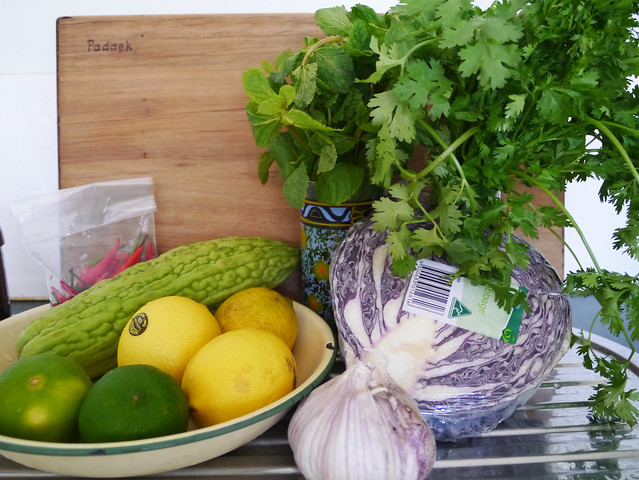
Some of the ingredients/vegetables/herbs that you’ll need for this recipe. Most can be found at your local supermarket or Asian grocer.
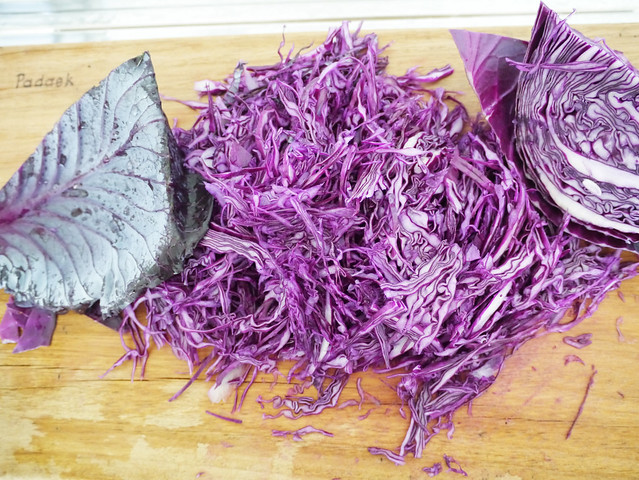
Thinly slice the cabbage. White/green cabbage works perfectly for this dish. Likewise, the red/purple variety.
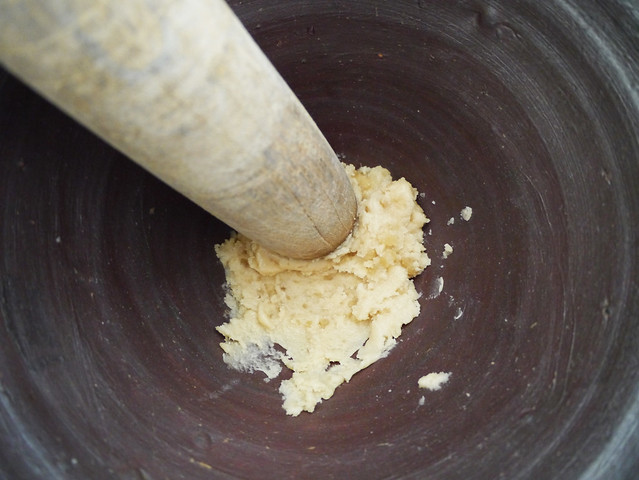
If your palm sugar is in a rock form, pound a small amount in a mortar and pestle so that you can measure and use it easier.
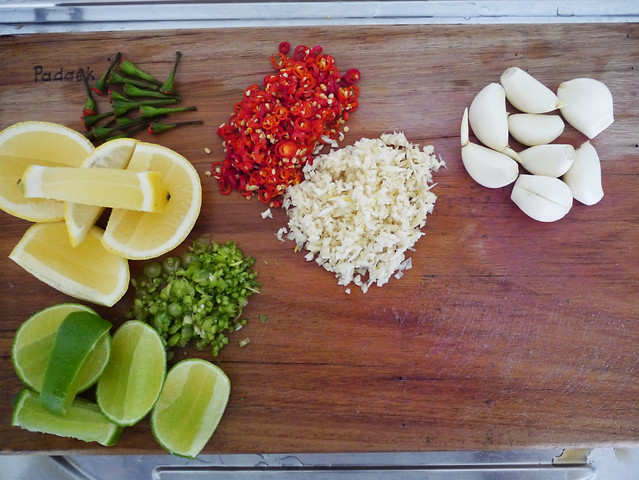
Next, finely chop the chilies, garlic and coriander root. Slice the lemon/lime into wedges.
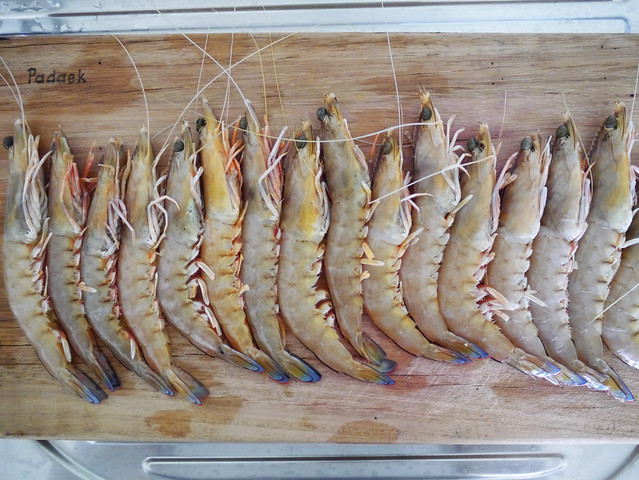
Fresh king prawns from the local fish/seafood market.
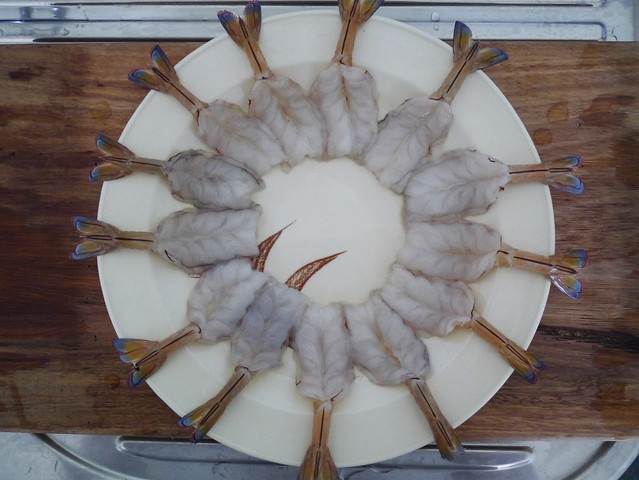
First, prepare the prawns. Carefully and neatly remove the heads and body shells. Keep the tail tip shell intact for presentation. Cut along the back of the prawns to remove the vein and then ‘butterfly’ them so that they lay flat. If you prefer, after you’ve peeled and butterflied the prawns, you can quickly blanch them in hot water for about 20 seconds (or longer) to semi-cook them. Arrange the prawns on a plate, cover them with glad wrap, and place them in the fridge while you prepare the other ingredients.

Mix the chopped chilies, garlic and coriander root together in a bowl. Add the fish sauce, palm sugar, and squeeze the lemon juice into the bowl, and mix together well. Adjust the flavours to suit your preference. You’re aiming for a balanced yet intense flavour of sour, spicy, fish-saucy with a hint of sweetness.
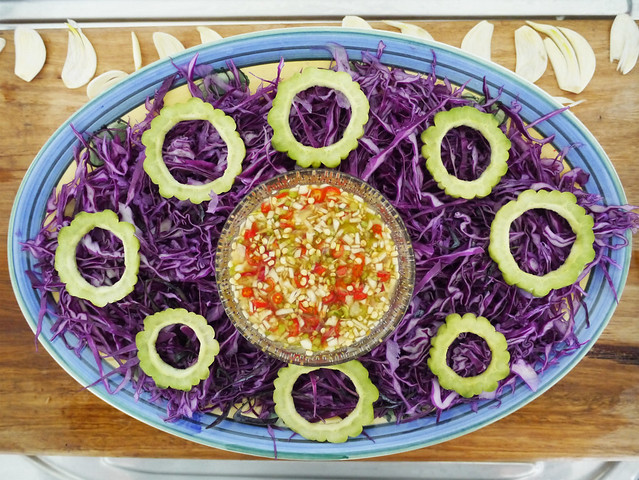
On a serving plate, arrange a generous bed of thinly sliced cabbage. Then, arrange slices of the bitter melon on top of the cabbage.
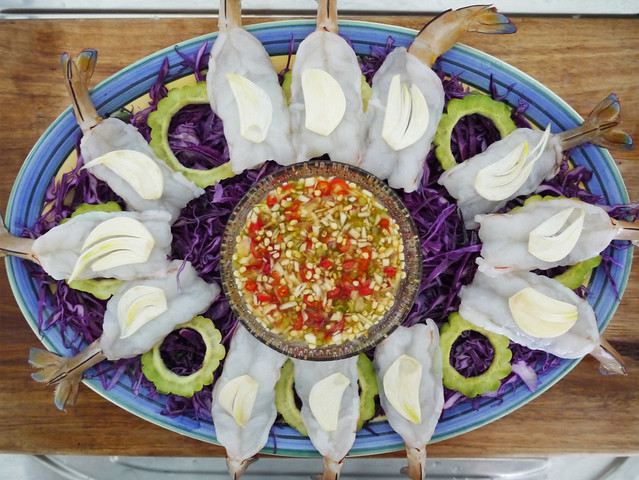
Arrange the butterfly prawns neatly on top of the cabbage and bitter melon. Place a thinly sliced piece of garlic on top of each prawn.

Place a mint leaf on top of each piece of garlic.
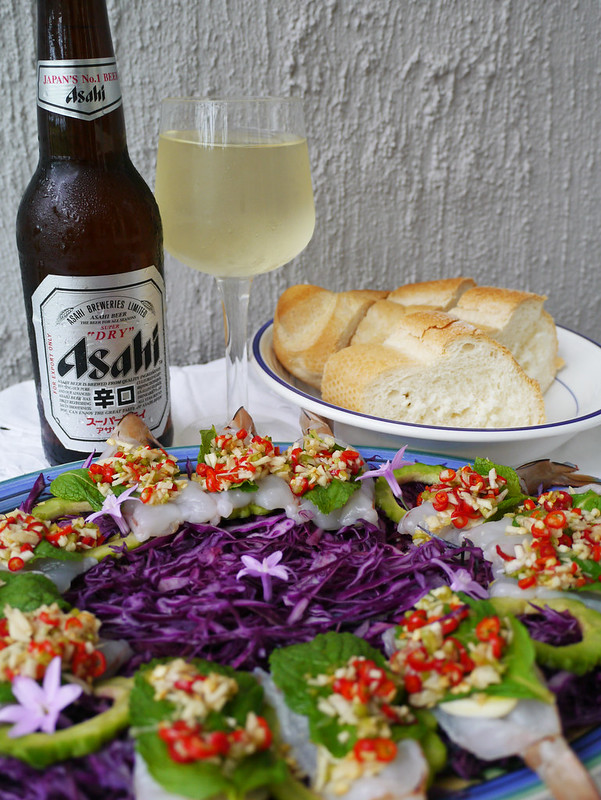
‘Goong che nam pa’ is best enjoyed with sticky rice or bread/baguette, and an icy cold bottle of beer or wine.

Your dish is now ready to be served and eaten. You can serve the dish with a bowl of the chili dressing/sauce on the side, or poured on top of the prawns.

Enjoy this delectable dish with steaming hot sticky rice or sourdough or baguette, and icy cold bottles of beer to counter the fiery chili heat!
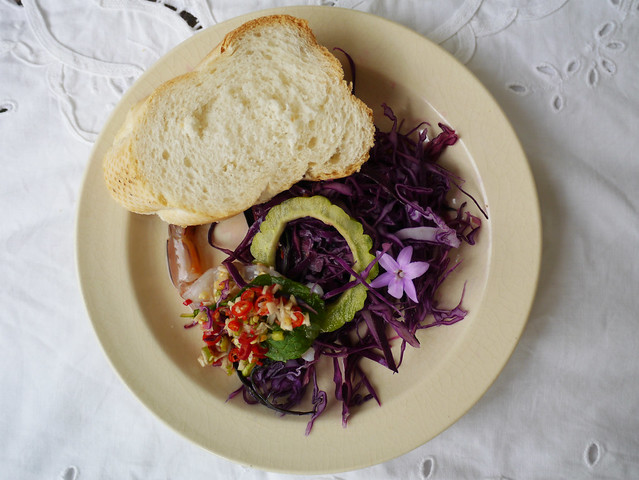
‘Goong che nam pa’ can be enjoyed with friends, shared from the same main plate, or served onto individual smaller plates with sticky rice and/or bread/baguette. Use your hands/fingers, knife and fork or chopsticks – what ever you feel comfortable with.
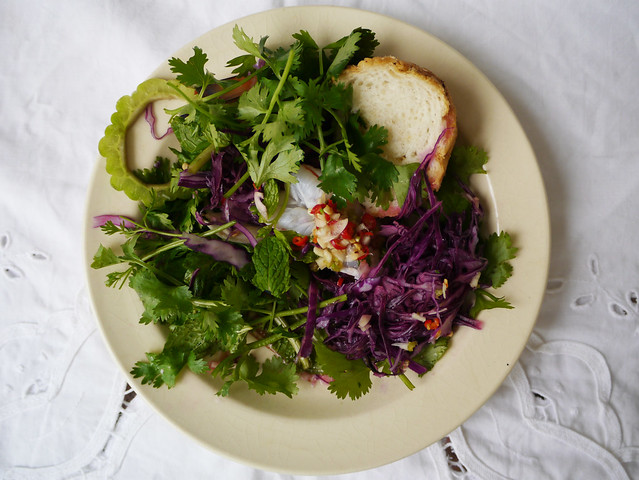
You can optionally serve the dish with extra herbs (mint, coriander, etc.), edible flowers, or other fresh vegetables, eg: lettuce, rocket, etc. Our chilies from the Asian grocer was exceptionally fiery (even for me), so to balance the heat, I chopped and added extra mint and coriander on top of the dish.
- 500 grams of fresh prawns (or 12 king prawns)
- 10 hot chilies (finely chopped)
- 5 cloves of garlic (finely chopped)
- 12 thin slices of garlic (sliced lengthways)
- 1½ tsp of palm sugar (or brown sugar)
- 1 large coriander root and stem (finely chopped)
- 2 Tbsp of fish sauce
- 1 large lemon (or lime)
- 12 mint leaves
- ½ a head of cabbage (thinly sliced)
- 1 bitter melon (thinly sliced)
- First, prepare the prawns. Carefully and neatly remove the heads and body shells. Keep the tail tip shell intact for presentation. Cut along the back of the prawns to remove the vein and then 'butterfly' them so that they lay flat. View the demo photo above as a guide. If you prefer, after you've peeled and butterflied the prawns, you can quickly blanch them in hot water for about 20 seconds (or longer) to semi-cook them.
- Arrange the prawns on a plate, cover them with glad wrap, and place them in the fridge while you prepare the other ingredients.
- Next, finely chop the chilies, garlic and coriander root.
- Slice the lemon/lime into wedges.
- If your palm sugar is in a rock form, pound a small amount in a mortar and pestle so that you can measure it easier and use it.
- Thinly slice the cabbage.
- Thinly slice the bitter melon into rings and remove the seeds.
- Mix the chopped chilies, garlic and coriander root together in a bowl.
- Add the fish sauce, palm sugar, and squeeze the lemon juice into the bowl, and mix together well. Adjust the flavours to suit your preference. You're aiming for a balanced yet intense flavour of sour, spicy, fish-saucy with a hint of sweetness.
- On a serving plate, arrange a generous bed of thinly sliced cabbage. Then, arrange slices of the bitter melon on top of the cabbage.
- Arrange the butterfly prawns neatly on top of the cabbage and bitter melon.
- Place a thinly sliced piece of garlic on top of each prawn.
- Place a mint leaf on top of each piece of garlic.
- Your dish is now ready to be served and eaten. You can serve the dish with a bowl of the chili dressing/sauce on the side, or poured on top of the prawns.
- Enjoy this delectable dish with steaming hot sticky rice or sourdough or baguette, and icy cold bottles of beer to counter the fiery chili heat!
What you’ll need:
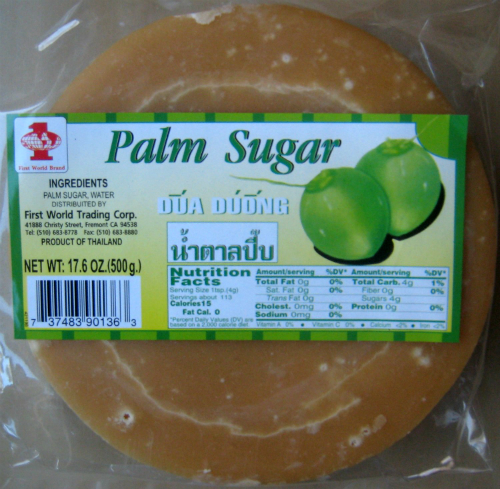
Did you know?
- When fishing in NSW waters, both freshwater and saltwater, you are required by law to pay the NSW Recreational Fishing Fee and carry a receipt showing the payment of the fee. This applies when spear fishing, hand lining, hand gathering, trapping, bait collecting and prawn netting or when in possession of fishing gear in, on or adjacent to waters. 2
- Palm sugar have low glycemic index (around 35), which means they don’t have the blood-sugar spiking effect (‘sugar high’) that regular refined sugar causes. In India, palm sugar is actually used in traditional medicine, since it contains many minerals and has been found to heal throat and lung infections. 3
- To store fresh mint: 1) Trim the ends and place in a glass containing one inch of water; 2) Cover with a loose-fitting plastic bag and refrigerate; 3) Replace water when it gets cloudy. This will keep the mint fresh for 7-10 days. 4
Notes:
- Reference: http://www.durrasnorthpark.com.au. ↩
- Reference: http://www.dpi.nsw.gov.au. ↩
- Reference: http://thaifood.about.com. ↩
- Reference: http://www.stilltasty.com. ↩
It looks so beautiful and colourful!
Thanks Emma, I had a lot of fun preparing and photographing this dish. I’m really happy with how the photos turned out too. The dish is delicious and colourful but incredibly hot – of course, you can adjust the heat to suit your taste buds. :)
Wow your photographs are really nice. I don’t know if I can say it enough how much I love your site. Are there a lot of Lao people in Australia?
Thanks so much Miemo, I really appreciate it. The site is a work in progress and I hope the number of ads on it doesn’t scare away my readers too much. I’ll balance it out soon. I don’t know the number of Lao people living in Australia so I just searched it and found out that it’s about 10,000 Lao people. Although, I think it’s an old statistic so there’s probably more now. I’m enjoying your site a lot too. Have a great day!
Oh wow, you make me want to eat your photos! The last time I had goong che nam pa was about 20 years ago. There was a group of Thai friends that I made in Vientiane and I had to peel like a pound of garlic! It was for sure delicious but I wasn’t into cooking it for myself. Now I’ll try again since living in Bangkok.
We are safe and sound despite the protesting. Thanks for asking:)
Hi Ping, Eating goong che nam pa/pla is something to be shared with family and friends. The heat sensation is intense so you shouldn’t need to suffer/enjoy it alone. Making it can be time-consuming but well worth the effort. Good to know you and your family are safe and well. Thanks for your comment and best wishes!
This is a stunning dish! I sooo want to try it :) I love the punch-y flavors of thai cuisine!
Hi gastronomiette, I’m so sorry, I just randomly found out that I’ve left your comment unresponded for months. I love the addictive flavours of Thai cuisine too. You should give this dish a try, perhaps make it for your family? It’s a little fiddly to prepare but the taste sensation is out of this world, and you can adjust it to suit. You can serve the prawns cooked or blanched.
Looks delicious! :)
Hi thenomadicpanda,
Thanks for your visit and comment. I’m glad you like the look of the raw prawn salad. Best wishes!
Oh my goodness, this spread is so beautiful, ALL of your photos are beautiful! Would love to use this image in our Thanksgiving newsletter, would that be possible? And of course, I’d love to interview you for the blog as well :)
Hi catzuella,
Thanks very much for your visit and kind comment. I appreciate it. Please contact me and let me know which photo you would like to use, and the details about the interview. To prevent spam, can you please contact me via the contact page. My email is there also. Happy thanks giving to you and yours, and talk to you soon. Best wishes!
This is a typical Lao dipping sauce that one can use on vegetables, meats, and cooked/raw seafood including prawns. Laos has freshwater seafood. Lao cuisine is known for not just its cooked dishes, but also its raw dishes, too. Lao cuisine has many raw seafood dishes that use fish or prawns. This raw shrimp salad is originally a Lao dish just like larb and papaya salad. This sauce and salad are Lao style and were introduced to Thailand from Laos.